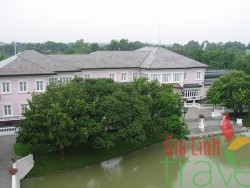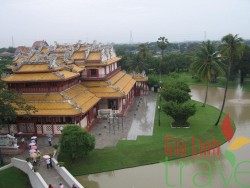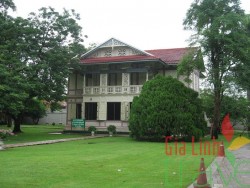Ayutthaya
Ayutthaya
Ayutthaya Ayutthaya Ayutthaya is one of Thailand’s historical highlights. Founded c. 1350, Ayutthaya became the second Siamese capital after Sukhothai. It was destroyed by the Burmese in the 18th century. Its remains, characterized by the prang (reliquary towers) and gigantic monasteries, give an idea of its past splendor. The Phra Nakhon Si Ayutthaya or Ayutthaya in short is one of Thailand’s historical and majestic highlights. Serving as the Thai capital for 417 years (1350 1767: Kingdom of Ayutthaya), it was once glorified as one of the biggest cities in Southeast Asia. During the 17th century, most foreign visitors to Ayutthaya, traders or diplomats alike, claimed Ayutthaya to be the most illustrious and glittering city that they had ever visited. The Kingdom of Ayutthaya reached its apex in terms of sovereignty, military might, wealth, culture, and international commerce in the 16th century when the Kingdoms territory was extended far beyond present-day Laos, Cambodia, and Myanmar. Ayutthaya even had diplomatic relations with Louis XIV of France and was courted by Dutch, Portuguese, English, Chinese and Japanese merchants. Visitors can explore and appreciate Thai history in Phra Nakhon Si Ayutthaya, which is situated only 86 kilometers north of Bangkok. Visitors to Ayutthaya can marvel at its grandeur reflected through numerous magnificent structures and ruins concentrated in and around the city island surrounded by Maenam Chao Phraya, Maenam Pa Sak and Maenam Lopburi. More importantly,Phra Nakhon Si Ayutthaya Historical Park, an extensive historical site in the heart of Ayutthaya city, has been included in UNESCO’s World Heritage list since 13 December, 1991. The Kingdom of Ayutthaya was built and developed in leaps and bounds. The ruins in Ayutthaya that survived the test of time embody both the glorious and ignominious stories of the Kingdom. This ancient capital of the Kingdom of Ayutthaya, founded in 1350 by King U-Thong, had thirty three kings of different dynasties and reached its peak in the middle of the18th century. A magnificent city with three palaces and over 400 magnificent temples on an island threaded by canals Ayutthaya was truly an impressive city that attracted both Europeans and Asians. After a 15-month siege the Kingdom of Ayutthaya was conquered and completely destroyed by the Burmese in 1767. When King Taksin the Great finally liberated the Kingdom, a new dynasty was established and the capital was moved to Thonburi. The seal of Ayutthaya depicts a conch on a pedestal tray placed in a small castle under a Mun tree. According to legend, King U-Thong, founder of the Kingdom of Ayutthaya, discovered a beautiful conch buried in the ground being prepared for the establishment of the seat of his Kingdom. Consequently, he had a tiny castle built to house the shell. Hence, the provincial seal. Today, there are but groups of crumbling ruins and rows of headless Buddhas where once an empire thrived. The temple compounds are still awe-inspiring even in disrepair and a visit here is memorable and a good beginning for those drawn to the relics of history. The architecture of Ayutthaya is a fascinating mix of Khmer (ancient Cambodian style) and early Sukhothai style. Some cactus-shaped obelisks, called prangs, denote Khmer influence and look something like the famous towers of Angkor Wat. The more pointed stupas are ascribed to the Sukhothai influence. For new arrivals who had limited their visit to Bangkok, similarities may be noted with the riverside Wat Arun, an 18th-century structure that was built in the so-called Ayutthaya style, a melding of Sukhothai Buddhist influences and Hindu-inspired Khmer motifs. The Royal Palace of Ayutthaya, which is now known as the Old Palace, is situated next to the northern section of the city wall. King Borom Trailokanath turned the palace, which was built in 1350 by King U-Thong, the first sovereign of the kingdom, into a monastery (Wat Phra Si Sanpet) in 1448 when he declared the three grand wooden prasats built by King U-Thong as a phuttawat or religious zone. The Royal Palace of Ayutthaya, which is now known as the Old Palace, is situated next to the northern section of the city wall. King Borom Trailokanath turned the palace, which was built in 1350 by King U-Thong, the first sovereign of the kingdom, into a monastery (Wat Phra Si Sanpet) in 1448 when he declared the three grand wooden prasats built by King U-Thong as a phuttawat or religious zone. King Borom Trailokanath then extended the palace grounds further north towards the Lopburi River, which was then used as the city’s moat. Several halls have been built since then. Places of interest in the Royal Palace are as follows:- King Borom Trailokanath built this hall which was used as a reception hall for foreign visitors as a sister to the Benjarat Maha Prasat Hall. This prasat-style hall had long porticoes both at the front and the back, with shorter ones on the sides and a small Mondop situated on a mini balcony on the front portico. Tin sheets covered the roof and bralee or small spikes decorated its ridges. In addition, there was a tall spire on top of the roof. On both sides of this hall were stables that housed the white elephants. When Ayutthaya fell to the Burmese the hall was burnt down and only its brick and mortar foundations survives. King Rama IV, desirous of honoring the Kings of Ayutthaya, sent a team of officials from Bangkok to built a small prasat on the foundation of Sanphet Prasat Hall and planned to install a plaque inscribed with the names of all Ayutthaya’s kings. However, he died before the construction was completed. In 1907 King Rama V had the unfinished prasat pulled down and built a ceremonial pavilion instead. King Prasat Thong built this prasat-style hall in 1632 on the inside wall of the palace towards the east. In this hall the king received an envoy sent by the Burmese King to protest King Prasat Thong’s proposal to reform the calendar. During the Bangkok period, King Rama I built a pavilion on top of the outer-wall of the palace in the same manner and it was used to view the processions or the military exercises. This building, which is believed to be the garden house inside the inner court, is located behind Sanphet Prasat Hall but its date of construction is unknown. The name was first mentioned in the reign of King Borom Rachathirat II in 1427 when it was destroyed by fire. It is believed that the original hall was a wooden structure built on top of a plain foundation and the floor was covered with terracotta slabs. It was a long twin building similar to Sanphet Prasat Hall. The original foundation is still visible. When King Rama V celebrated the 40th anniversary of his coronation in 1907 he had wooden models of various Ayutthayan halls built on top of the original sites and one of which was built on top of the foundation of Trimuk Hall. In addition, when King Rama VI and King Rama VII ascended to the throne they conducted religious rites in honor of the former Kings in Trimuk Hall and in 1953, the Fine Arts Department renovated the Hall. Great blessings: Victory over enemies, forgiveness and being the beloved Great blessings: Smooth-running business, prosperity in one’s job *Maravijava (conquering mara) posture is a sitting position with legs crossed, the left hand on the lap and the right hand on the right knee with fingers pointing down to the ground. Great blessings: Prosperity in trade, success in one’s job The right arm from the shoulder fell off. A few years ago, the Fine Arts Department discovered lots of small Buddha images inside the left chest. Great blessings: Being the beloved, good health There is a stupa encircled by lion figures, reflecting the Khmer influence. Legend has it that Queen Ubon Dhevi of this king asked the gods for the recovery of her son. The prayer was granted. Thus, she erected the reclining Buddha image with a length of 12 metres there. Both soles were gilded with gold leaf and decorated with stained glass. Great blessings: Being the beloved, invulnerability, good health Great blessings: Being the beloved, invulnerability, prosperity in one’s jobs *A bai sima is a heart-shaped stone placed outside a temple to mark its boundary. Usually, there are eight of them in eight directions. As for the royal temples, there are sixteen of them. Great blessings: A great merit of worshipping the triple gem of the Buddha Great blessings: Prosperity, being the beloved Great blessings: Being the beloved, strong health, safety from all weapons


The Past
The Present
Royal Palace
Sanphet Prasat Hall
Chakawat Paichayon Hall
Trimuk Hall
Ayutthaya’s Great Blessings: Paying Homage to Nine Temple
1. Wat Yai Chai Mongkhon
Located in the Southeast of the Ayutthaya Muang Island, the temple was established in 1357 AD in the reign of King U-thong (1350-1369). The Great Chedi Chai Mongkhon, a token of King Naresuan’s victory over the Crown Prince of Burma in the duel on elephant back, was erected later in the reign of King Naresuan (1590-1605) at the same time of the temple renovation. Phra Phuttha Chaiya Mongkhon in the ordination hall is one of the most sacred Buddha images in Ayutthaya. 2. Wat Phanan Choeng
This is a Mahayana temple situated to the Southeast of the Ayutthaya Muang Island. It is presumed to be built before the establishment of the Ayutthaya kingdom. The huge maravijaya* Buddha image (height 19 m./width 20.17 m) in the ordination hall, Luang Pho To (the big Buddha) or Sampokong, is greatly revered not only by the Thais and the Chinese-Thais but also by the Chinese from abroad. This is because most worshippers have found that their business and trading have become prosperous after paying homage to Luang Pho To.3. The Vihara of Phra Mongkhon Bophit
Situated in the south of Wat Phra Si Sanphet on the Ayutthaya Muang Island, the monastery has no monks residing. The principal bronze Buddha image, Phra Mongkhon Bophit, is presumed to be built in the reign of King Sanphet VIII or King Tiger (1703-0708). In 1767, when Ayutthaya fell to the Burmese, the vicinity of the monastery was set on fire to remove the gold that gilded the stupas there. Phra Mongkhon Bophit was burnt too. 4. Wat Thammikkarat
Situated in the east of the site of ancient royal palace, the temple has existed since the reign of King Borom Trai Lokkanat (1448-1488).5. Wat Phutthai Sawan
The temple is located in the southern side of the Chao Phraya River, opposite the Ayutthaya Muang Island. It was established in the reign of King U-thong (1350-1369). At that time, the vicinity was called “wiang lek”and used to be the palace of the king. 6. Wat Kasattrathirat
Located on the Chao Phraya riverside, to the west of Ayutthaya Muang Island, this ancient temple was renovated in the first reign of the Rattanakosin Period (1782-1809). The double bai simas* of the ordination hall were magnificently carved.7. Wat Tha Ka Rong
The temple is located near the Chao Phraya riverside to the west of the Ayutthaya Muang Island. It was built before Ayutthaya became capital. There is no evidence telling who the founder was. The ancient principal Buddha image in the ordination hall, Luang Pho Rattana Mongkhon, is highly revered by the villagers.8. Wat Na Phra Mane
Situated in the north of the Ayutthaya Muang Island, it is the only temple in Ayutthaya that was not destroyed during the siege of 1767, because it was used as headquarters of the Burmese invaders. The ordination hall has no windows like other temples erected in the Ayutthaya period. Instead, it has several small openings on the walls with carved stone bars for ventilation. 9. Wat Nakhon Luang
Situated on the Pa Sak riverside in Amphoe Nakhon Luang (20 km from the provincial town). In the Ayutthaya period, the area was part of the royal route for all kings who travelled to pay homage to Phra Phuttha Bat (the Buddha’s footprint) in Saraburi province. In the same vicinity of the temple, Nakhon Luang Palace which was used as royal residence for all kings and royal families is situated. It is presumed to be built in the reign of King Song Tham (1610-1628) and was renovated in the reign of King Prasat Thong (1629-1656).
